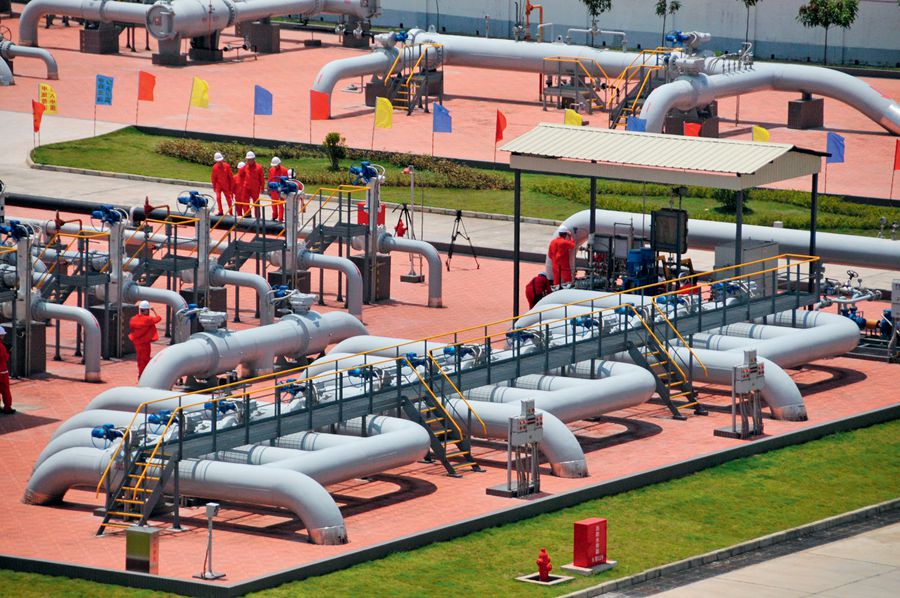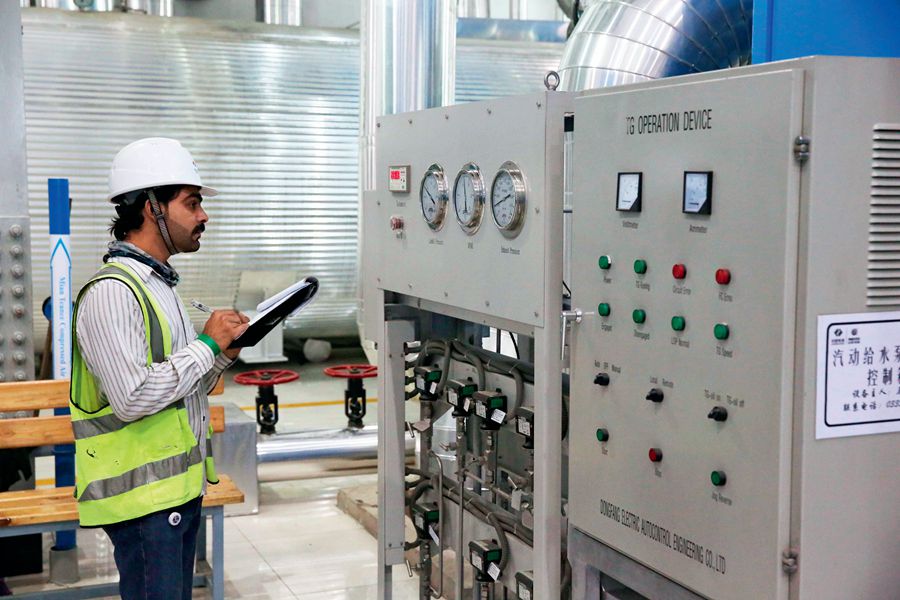DISPROVING all qualms and critics’ pontifications that the Belt and Road Initiative (BRI) has bedeviled South Asia by landing economies in debt traps, controlling markets, and manipulating governments; the BRI is empowering south Asian nations through broad-based upturn in regional connectivity, innovative infrastructure, socio-economic growth, poverty alleviation, employment fortunes, and financial development.
Over the last five years, the BRI, the epic vision of Chinese President Xi Jinping, has materialized as an empirical reality. Attributed to its empowering influence, South Asia, once labeled as the land of ailing economies, has made an impressive turnaround claiming back its leading role in global growth. This leading role is going to be complemented and further consolidated as China’s annual trade with BRI countries is hoped to exceed US $2.5 trillion in a decade.
The BRI has breathed fresh vitality into South Asia and helped the region reshape its international relations, said the Asian Competitiveness Annual Report 2018. China’s Belt and Road Initiative, a key driver of prominent geopolitical and geo-economic developments, addresses all commercial aspirations of South Asia, which hosts the China-Pakistan Economic Corridor (CPEC) and Bangladesh-China-India-Myanmar Economic Corridor (BCIM) with infrastructural upgrades to Sri Lankan ports.

On May 19, 2017, the China-Myanmar Oil and Gas Pipeline formally starts to transfer oil into China, as a forerunner BRI cooperation project in Myanmar.
Inspired by the Silk Road Economic Belt and 21st-century Maritime Silk Road since the BRI proposal in 2013 to date, South Asia’s growth rate is estimated to swell to 6.9 percent during the ongoing year.
According to the World Bank Report 2018, Pakistan is likely to accelerate to 5.8 percent in 2018-19. Bangladesh will pick up at 6.7 percent. Sri Lanka is projected to rise to five percent as exports are on the track of revival, domestic demand robust, and investment flows healthy. “Afghanistan, Maldives, Nepal, and Bhutan have a great opportunity to give a new push to their growth rates if they agree to join the epic BRI,” says Haroon Raja, senior economist.
Infrastructure Progress
Most of CPEC’s major infrastructure projects are nearing completion. Linking Kashghar City of Xinjiang Uygur Autonomous Region of China to the Gwadar port of Balochistan Province of Pakistan, they are going to form a modern trade corridor. Offering fast and qualitative logistics, and travel and transport facilities, the new alignments will blaze trails in economic growth. Pakistan’s rail network dealt with over 70 percent of the national freight load in the 1970s, which reduced to just four percent in recent years. Experts believe that this would increase to 21 percent after CPEC rail projects complete with freight traffic increasing from five to 25 million tons per annum by 2025. The passenger traffic is also predicted to increase by 46 percent from 55 to 80 million passengers per annum.
Under the Belt and Road Initiative, Chinese companies completed more than US $15 billion worth of infrastructure in Sri Lanka. In order to materialize the action plan, the surrounding infrastructure is also being revamped. This will see two looped roadways, linked to an underground tunnel, providing a direct connection to Sri Lanka’s expressway network, streamlining access to other major cities in the region. A new inter-city train link will also connect to Colombo’s light-rail system. The China-backed Karnaphuli Multi-Channel Tunnel Project in southern Bangladesh, a key component in several BRI projects, will connect the port city of Chittagong to the far side of the Karnaphuli River, the site of a new economic zone. Due to be completed in 2020, the tunnel will drastically cut the travel time between Chittagong and Cox’s Bazar, one of the country’s leading tourist destinations, and ease the heavy traffic congestion on the two existing bridges across the river, while also connecting with the Korean Export Processing Zone and Shah Amanat International Airport. It will also feed into two other projects that are currently under way – the Asian Highway and the Dhaka-Chittagong-Cox’s Bazar Highway.
Development of Ports
Gwadar, the terminal point of CPEC, once a sleepy fishing town at the coast of the Arabian Sea in Pakistan’s southwest Balochistan Province, is now a fully functional port terminal, with regular cargo services, a free trade zone, and a business center, becoming an economic lifeline for Pakistan. According to China Overseas Ports Holding Company (COPHC), the port’s operator, some 20 companies in different businesses have already joined the Gwadar free trade zone with direct investments of over US $460 million.

Qasim Coal Fired Power Plant in Pakistan is the first large-scale energy project in the China-Pakistan Economic Corridor.
The living standards of Gwadar’s locals are also showing signs of improvement. New roads have been constructed, educational institutions and hospitals established and upgraded, water purification plants installed, and a new international airport constructed. People in droves, from laborers to businessmen, have been moving to Gwadar and surrounding areas to reap the benefits of emerging opportunities for business and employment due to the launch of CPEC.
Taking advantage of the BRI bonanza, Sri Lanka is also trying to restore its pivotal role as an attractive maritime interchange for cargo bound for multiple destinations across Europe and Asia. In order to achieve this, a total of 269 hectares of land has to be reclaimed from the sea between the South Harbor of the Colombo International Container Port Terminal and Galle Face Green. Once the reclamation work ends in 2019, the area will see spiraling commercial developments in a series of phases until 2041, providing massive business opportunities and a high number of jobs.
Energy Solutions
Pakistan had been suffering acute power shortages with power cuts of up to 20 hours a day over the last few years. The power outages triggered public anger and hindered both industrial and economic activity greatly.
CPEC’s power projects eased the situation. A total of US $33.8 billion in energy projects have added up to 12,230 Megawatts of energy. Access to electricity for the urban population increased from 90 percent in 2015 to 98.8 percent. Pakistan’s Ministry of Planning, Development and Reform hopes that after all CPEC energy projects are completed, the country’s current electricity production will be doubled. The 1,320-megawatt Sahiwal coal-fired power plant and the Port Qasim coal-fired power plant with the same capacity have already started production. They are expected to generate 18 billion kWh of electricity together annually, which can cater to the needs of eight million households.
Under the Belt and Road Initiative, China and Sri Lanka jointly constructed many mega projects including the Lakvijaya Power Station which has been providing about 40 percent of the nation’s electricity supply and ended the scourge of frequent power cuts in the country. A US $700 million natural gas-powered electrical station in the Chinese-run port of Hambantota with a capacity of 400-gigawatt will also be activated soon.
Employment Opportunities
Chinese companies under CPEC projects have provided over 100,000 jobs to local people and have helped to uplift their living standards through social welfare campaigns, including restoring and establishing schools and technical training centers, providing health facilities, and sending hundreds of youngsters to China for further study. Up to 800,000 direct jobs are estimated to be generated over the next 15 years, says the Ministry of Planning, Development and Reform. For Pakistan, CPEC will cut unemployment by 2.32 million by the end of 2018. Seventy-five percent of the total employees working in CPEC projects are Pakistanis, contrary to the belief that the Chinese have a higher representation.
Sri Lanka, after the end of the three-decade-long war against the Tamil militants in 2009, had been languishing badly. It direly needed strong support to boost economic activity and reduce the alarming rate of unemployment. At that critical juncture when the situation for Sri Lanka seemed dire, China came up with the BRI with a sizable funding influx to rebuild the struggling island nation. The Colombo Port City and Financial City are providing more than 80,000 jobs. Meanwhile, a Special economic zone of 55-sq-km in Hambantota will transform Sri Lanka into an international hub and improve people’s livelihoods. According to Paban Chowdhury, BEZA’s executive chairman, the special economic zone will have the capacity to house 150-200 industrial units, and will provide 75,000 jobs as well as focus on a range of different industrial sectors, including shipbuilding, pharmaceuticals, electronics, agro-business, IT, chemicals, power, and textiles.
Bangladesh was once plagued by rampant unemployment. With the blessing of BCIM, joblessness is being reduced as a number of projects undertaken by Chinese companies in Bangladesh are advancing well. For instance, the factory of Amigo Bangladesh Limited and its auxillary facilities are run by the China Railway Port and Channel Engineering Group. The company is a major garment manufacturer in Bangladesh. The project has provided thousands of jobs for locals and trained engineering and management personnel, technicians, and equipment operators.
BRI is also playing a vital role in Sri Lanka’s poverty reduction initiative. Currently, the Sri Lankan government has made impressive progress in extreme poverty reduction, and the proportion of the population in poverty is down to 6.7 percent.
Taking advantage of BCIM related projects, Bangladesh has made stunning progress. The World Bank admits that Bangladesh has succeeded in reducing poverty.
“With a vibrant economy that has grown at more than six percent per year in the last decade, Bangladesh reduced extreme poverty to 13.8 percent in 2016 from 44.2 percent in 1991. The country now aspires to become a middle income country by its 50th anniversary in 2021,” the report discloses.
YASIR HABIB KHAN is a senior journalist working in CRI and China Today as a special contributor, and also a fellow of the International Center for Journalists.

